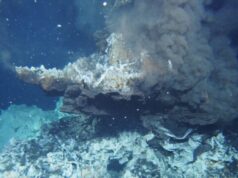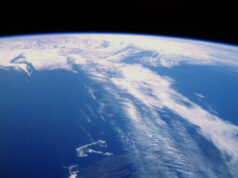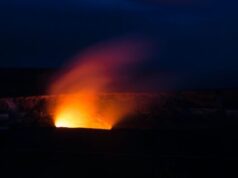Victor Camp has spent a lifetime studying volcanic eruptions all over the world, starting in Saudi Arabia, then Iran, and eventually the Pacific Northwest. The geology lecturer finds mantle plumes that feed the largest of these eruptions fascinating, because of their massive size and the impact they can have on our environment.
Over the past two years, this abiding interest helped him connect the dots and discover that the mantle source rock that rises upward from beneath Yellowstone National Park to feed its periodic supereruptions also spreads out west all the way to Northern California and Oregon.
On its westward journey, it acts as the catalyst for fairly young—meaning less than 2 million years old—volcanic eruptions at places such as Craters of the Moon National Monument and Preserve in Idaho, before reaching Medicine Lake Volcano in the northeastern tip of California, close to the Oregon border.
The mantle rock spreads laterally through narrow flow-line channels well below the earth’s crust for over 500 miles, bifurcating twice: once as it leaves Yellowstone and again as it reaches the California-Oregon border. These lines end at Medicine Lake, an active volcano near Mount Shasta, and at Newberry Volcano, an active volcano about 20 miles south of Bend, Ore.
This discovery is significant because it reveals how mantle plumes similar to the one beneath Yellowstone behave as they feed the majority of the world’s largest volcanic eruptions of basaltic lava, including the ones in Hawaii.
Find your dream job in the space industry. Check our Space Job Board »
“Since the plume is not controlled by plate tectonics, it can rise and emerge anywhere on earth, depending on where it manages to break through the earth’s surface,” Camp said. “So, knowing this will help us understand supereruptions that have occurred before, and those that will occur in the future.”
The results of his self-funded study were published in the journal Geology in May.
Mantle plumes are composed of very hot, low-density mantle rock. Mantle is one of three major layers of planet earth—we live on the earth’s crust, the thinnest layer, and mantle is the second denser layer that extends from about 100 kilometers (62 miles) below the earth’s surface all the way down to about 2,700 kilometers (about 1,680 miles), and further down is the core of the earth comprised mostly of iron mixed with a few other elements.
Mantle plumes are technically mantle rock, but because they are hotter and more buoyant than surrounding mantle they rise in a plume-like form. When the Yellowstone plume first reached the base level of the North American tectonic plate, it was blocked by the rigidity of the cold plate base which acted as a barrier. At this depth of about 100 kilometers, the plume began to decompress and melt, while simultaneously spreading laterally to the west.
The mantle rock that Camp traced to California took many millions of years to move out west. What’s interesting is that the source of the mantle rock under Yellowstone today originated at the core-mantle boundary geographically centered near present-day San Diego, but very deep beneath the earth’s surface we reside on—and took a circuitous route through different regions of the mantle before it rose up underneath the Yellowstone volcano.
Camp sourced seismic tomography images, similar to X-rays and CT-scans (computerized tomography scans), that show how the mantle plume ascended, and he analyzed field data as well as published chemistry and age data on volcanic rocks at the surface, to demonstrate its westward flow.
Provided by: San Diego State University
More information: Victor E. Camp. Plume-modified mantle flow in the northern Basin and Range and southern Cascadia back-arc region since ca. 12 Ma. Geology (2019). DOI: 10.1130/G46144.1
Image Credit: CC0 Public Domain











